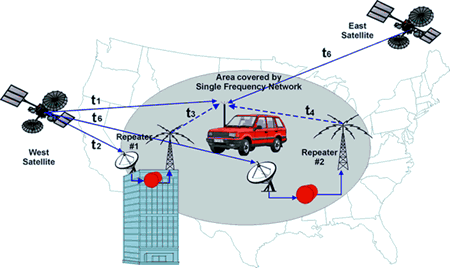

Our Senior Project is to design
and build an active integrated antenna to be used to receive an S.D.A.R.S.(Satellite
Digital Audio Radio Service) signal. This signal will be transmitted
digitally via satellites and will be resistant to fading, allowing the
user to receive the signal nationwide. The satellites will transmit
in the S-Band from 2.320GHz to 2.345GHz. Terrestrial stations located
throughout the U.S.A. near urban areas and major tunnels will supplement
this signal so that reception will never be lost. This technology
will be available in January 2001, and will be provided by two competing
companies that split the allocated bandwidth equally, resulting in 12.5MHz
bandwidth for each company.
Figure 1 shows how the
digital radio will be transmitted. First, the radio station will
upload the signal to the satellites, which will then broadcast over the
entire nation. The receiver will acquire the transmission to be heard
on a personal radio. In urban areas and near major tunnels, terrestrial
repeaters will receive the satellite signal and then transmit to areas
with potentially poor reception.

Fig. 1 – Overall System Diagram
This project focuses
on the front end of a personal receiver. A passive antenna integrated
with a low noise amplifier will be designed, fabricated, and interfaced
to a mixer. The block diagram for the project is shown below.
The input is the digital audio radio signal, which will be received by
the passive antenna. The RF signal will pass through a low noise
amplifier used to enhance the sensitivity of the receiver. This signal
will then enter into a mixer, which is also receiving a lower frequency
from the voltage controlled local oscillator. These two frequencies
are mixed together resulting in many carrier frequencies and their sidebands.
One of the resulting frequencies is RF freq – LO freq = Intermediate frequency
(IF). The IF signal is the same digital audio signal received from
the satellite but at a lower frequency. A band-pass filter is used
to separate this signal from the many frequencies generated from the mixer.
The IF signal is amplified to output a strong digital audio radio signal
ready for decoding.

Fig. 2 - Block Diagram of the Integrated Active Receiver Front End